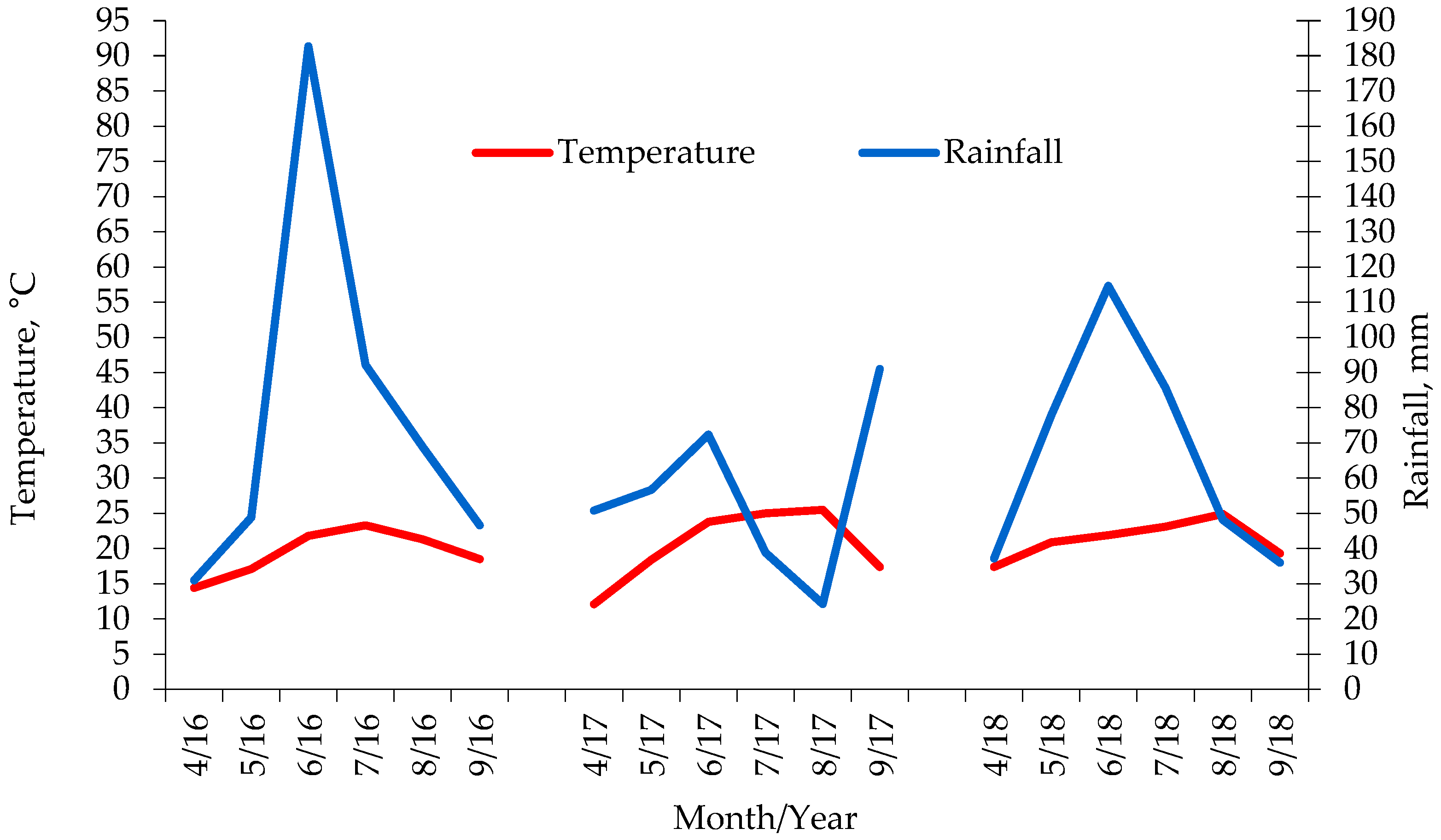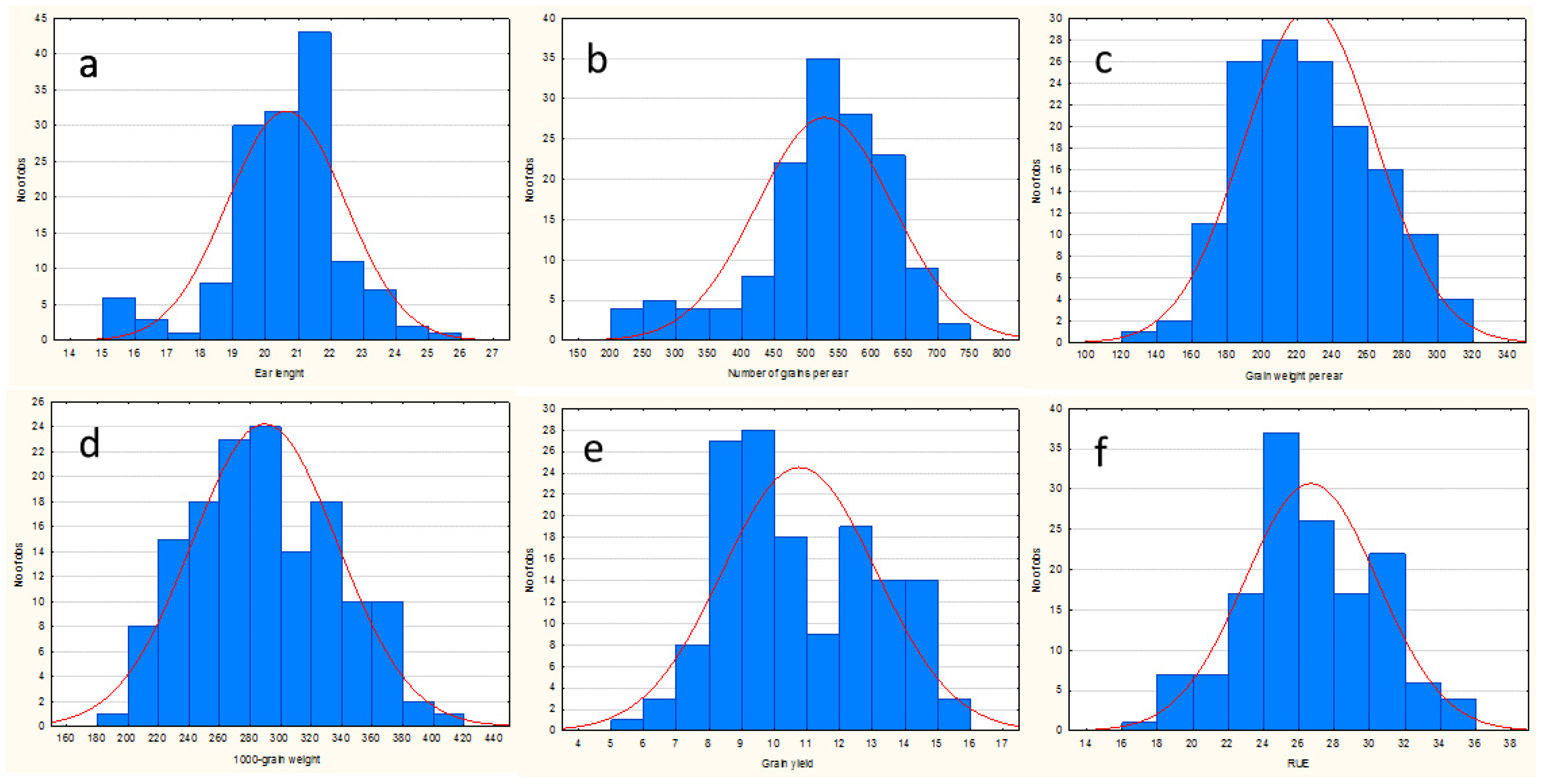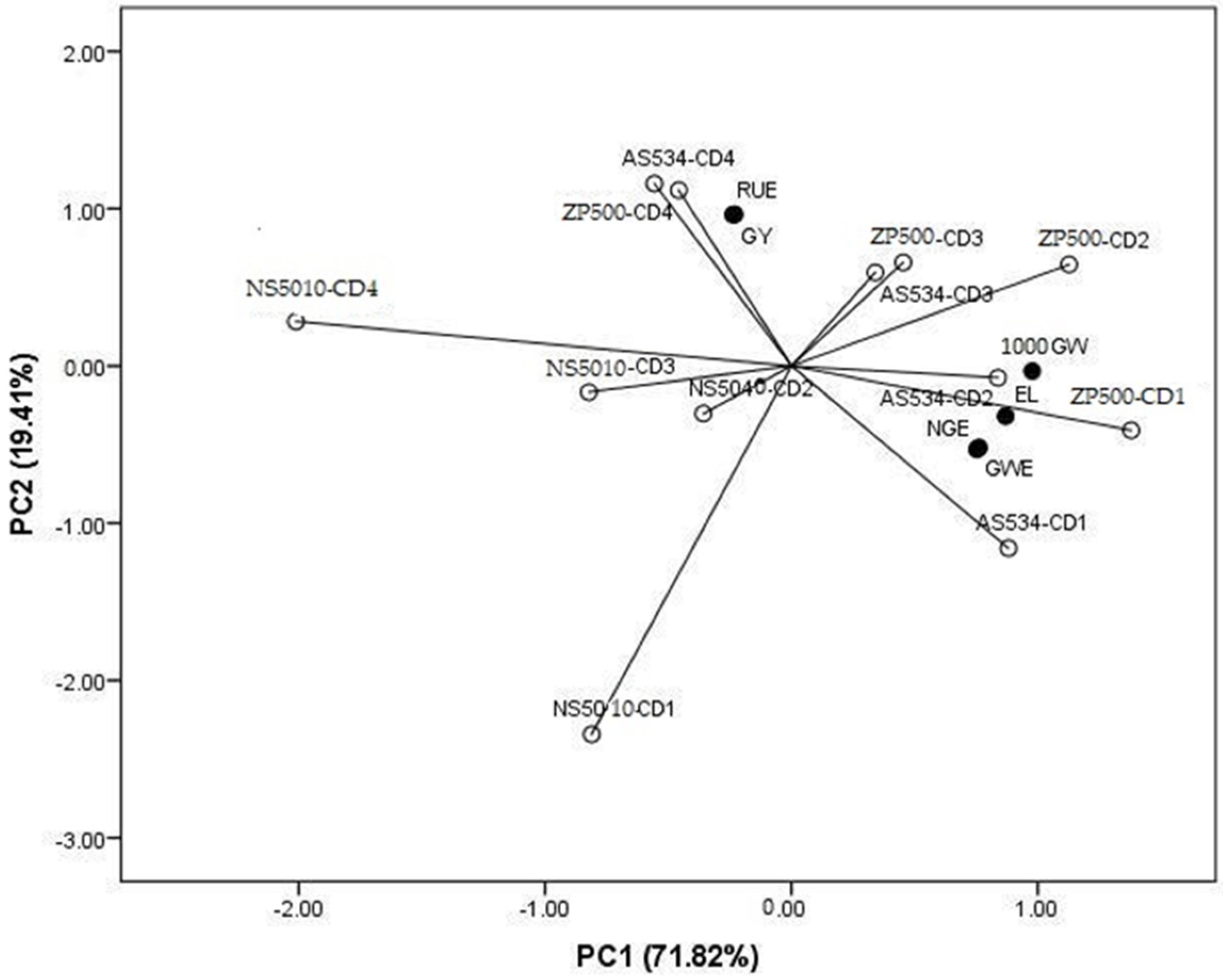Response of Yield Formation of Maize Hybrids to Different Planting Densities
Abstract
:1. Introduction
2. Materials and Methods
2.1. Experimental Trials and Treatments
2.2. Meteorological Data
2.3. Data Collection
2.4. Statistical Data Analysis
3. Results
3.1. Descriptive Statistics and Variations in Parameters
3.2. Yield Components, Grain Yield, and Rain Use Efficiency (RUE)
3.3. Yield Stability Index (CV, %) and Sustainable Yield Index (SYI)
3.4. Principal Component Analysis for Measured and Calculated Parameters and AMMI
3.5. Correlation between Studied Parameters
4. Discussion
5. Conclusions
Supplementary Materials
Author Contributions
Funding
Acknowledgments
Conflicts of Interest
References
- FAO. FAO Statistical Yearbook; Food and Agriculture Organization (FAO) of the United Nations: Rome, Italy, 2021; Available online: https://www.fao.org/faostat/en/#data/QCL (accessed on 29 December 2023).
- Statistical Yearbook of the Republic of Serbia, 2023; Statistical Office of the Republic of Serbia: Belgrade, Serbia, 2023.
- Haegele, J.W.; Becker, R.J.; Henninger, A.S.; Below, F.E. Row Arrangement, Phosphorus Fertility, and Hybrid Contributions to Managing Increased Plant Density of Maize. Agron. J. 2014, 106, 1838–1846. [Google Scholar] [CrossRef]
- Assefa, Y.; Vara Prasad, P.V.; Carter, P.; Hinds, M.; Bhalla, G.; Schon, R.; Jeschke, M.; Paszkiewicz, S.; Ciampitti, I.A. Yield Response to Planting Density for US Modern Corn Hybrids: A Synthesis-Analysis. Crop Sci. 2016, 56, 2802–2817. [Google Scholar] [CrossRef]
- Mandić, V.; Bijelić, Z.; Krnjaja, V.; Tomić, Z.; Stanojković-Sebić, A.; Stanojković, A.; Caro-Petrović, V. The Effect of Crop Density on Maize Grain Yield. Biotechnol. Anim. Husb. 2016, 32, 83–90. [Google Scholar] [CrossRef]
- Fahad, S.; Hasanuzzaman, M.; Mukhtar, A.; Ullah, H.; Saeed, M.; Khan, A.I.; Adnan, M. Environment, Climate, Plant and Vegetation Growth; Springer: New York, NY, USA, 2020. [Google Scholar] [CrossRef]
- Tokatlidis, I.S. Adapting Maize Crop to Climate Change. Agron. Sustain. Dev. 2013, 33, 63–79. [Google Scholar] [CrossRef]
- Djaman, K.; Allen, S.; Djaman, D.S.; Koudahe, K.; Irmak, S.; Puppala, N.; Darapuneni, M.K.; Angadi, S.V. Planting Date and Plant Density Effects on Maize Growth, Yield and Water Use Efficiency. Environ. Chall. 2022, 6, 100417. [Google Scholar] [CrossRef]
- Zhang, Y.; Xu, Z.; Li, J.; Wang, R. Optimum Planting Density Improves Resource Use Efficiency and Yield Stability of Rainfed Maize in Semiarid Climate. Front. Plant Sci. 2021, 12, 752606. [Google Scholar] [CrossRef] [PubMed]
- Du, X.; Wang, Z.; Lei, W.; Kong, L. Increased Planting Density Combined with Reduced Nitrogen Rate to Achieve High Yield in Maize. Sci. Rep. 2021, 11, 358. [Google Scholar] [CrossRef] [PubMed]
- Tang, L.; Ma, W.; Noor, M.A.; Li, L.; Hou, H.; Zhang, X.; Zhao, M. Density Resistance Evaluation of Maize Varieties Through New “Density–Yield Model” and Quantification of Varietal Response to Gradual Planting Density Pressure. Sci. Rep. 2018, 8, 17281. [Google Scholar] [CrossRef]
- Mylonas, I.; Sinapidou, E.; Remountakis, E.; Sistanis, I.; Pankou, C.; Ninou, E.; Papadopoulos, I.; Papathanasiou, F.; Lithourgidis, A.; Gekas, F.; et al. Improved Plant Yield Efficiency Alleviates the Erratic Optimum Density in Maize. Agron. J. 2020, 112, 1690–1701. [Google Scholar] [CrossRef]
- Jiang, X.; Tong, L.; Kang, S.; Li, F.; Li, D.; Qin, Y.; Shi, R.; Li, J. Planting Density Affected Biomass and Grain Yield of Maize for Seed Production in an Arid Region of Northwest China. J. Arid Land 2018, 10, 292–303. [Google Scholar] [CrossRef]
- Mandić, V.; Đorđević, S.; Bijelić, Z.; Krnjaja, V.; Ružić Muslić, D.; Petričević, M.; Simić, A. Effect of Intra-Row Spacing and Seed Inoculation on Stem Lodging, Yield and Rain-Use Efficiency of Maize under Different Climatic Conditions. Philipp. Agric. Sci. 2018, 101, 243–250. [Google Scholar]
- Ma, D.; Li, S.; Zhai, L.; Yu, X.; Xie, R.; Gao, J. Response of Maize Barrenness to Density and Nitrogen Increases in Chinese Cultivars Released from the 1950s to 2010s. Field Crops Res. 2020, 250, 107766. [Google Scholar] [CrossRef]
- Lacasa, J.; Gaspar, A.; Hinds, M.; Don, S.J.; Berning, D.; Ciampitti, I.A. Bayesian Approach for Maize Yield Response to Plant Density from both Agronomic and Economic Viewpoints in North America. Sci. Rep. 2020, 10, 15948. [Google Scholar] [CrossRef]
- IUSS Working Group WRB. World Reference Base for Soil Resources International Soil Classification System for Naming Soil and Creating Legends for Soil Maps. In World Soil Resources Reports, 106; FAO: Rome, Italy, 2015. [Google Scholar]
- Walter, H.; Lieth, H. Klimadiagram-Weltatlas; VEB Gustav Fischer Verlag: Jena, Germany, 1967. [Google Scholar]
- Li, C.X.; Ma, S.C.; Shao, Y.; Ma, S.T.; Lingling, Z. Effects of Long-Term Organic Fertilization on Soil Microbiologic Characteristics, Yield and Sustainable Production of Winter Wheat. Agric. Sci. China 2018, 17, 210–219. [Google Scholar] [CrossRef]
- R Development Core Team. R: A Language and Environment for Statistical Computing; R Foundation for Statistical Computing; R Development Core Team: Vienna, Austria, 2023; Available online: https://www.r-project.org (accessed on 29 December 2023).
- Bennie, A.T.P.; Hensley, M. Maximizing Precipitation Utilization in Dryland Agriculture in South Africa—A Review. J. Hydrol. 2001, 241, 124–139. [Google Scholar] [CrossRef]
- Luo, Y.Q.; Jiang, L.F.; Niu, S.L.; Zhou, X.H. Nonlinear Responses of Land Ecosystems to Variation in Precipitation. New Phytol. 2017, 214, 5–7. [Google Scholar] [CrossRef]
- Anami, S.; De Block, M.; Machuka, J.; Van Lijsebettens, M. Molecular Improvement of Tropical Maize for Drought Stress Tolerance in sub-Saharan Africa. Crit. Rev. Plant Sci. 2009, 28, 16–35. [Google Scholar] [CrossRef]
- Avramova, V.; AbdElgawad, H.; Zhang, Z.; Fotschki, B.; Casadevall, R.; Vergauwen, L.; Knapen, D.; Taleisnik, E.; Guisez, Y.; Asard, H.; et al. Drought Induces Distinct Growth Response, Protection, and Recovery Mechanisms in the Maize Leaf Growth Zone. Plant Physiol. 2015, 169, 1382–1396. [Google Scholar] [CrossRef]
- Videnović, Ž.; Dumanović, Z.; Simić, M.; Srdić, J.; Babić, M.; Dragičević, V. Genetic potential and maize production in Serbia. Genetika 2013, 45, 667–678. [Google Scholar] [CrossRef]
- Sah, R.P.; Chakraborty, M.; Prasad, K.; Pandit, M.; Tudu, V.K.; Chakravarty, M.K.; Narayan, S.C.; Rana, M.; Moharana, D. Impact of Water Deficit Stress in Maize: Phenology and Yield Components. Sci. Rep. 2020, 10, 2944. [Google Scholar] [CrossRef]
- Solomon, K.F.; Chauhan, Y.; Zeppa, A. Risks of Yield Loss Due to Variation in Optimum Density for Different Maize Genotypes under Variable Environmental Conditions. J. Agron. Crop Sci. 2017, 203, 519–527. [Google Scholar] [CrossRef]
- Zhang, M.; Song, Z.W.; Chen, T.; Yan, X.G.; Zhu, P.; Ren, J. Differences in Responses of Biomass Production and Grain-Filling to Planting Density Between Spring Maize Cultivars. J. Maize Sci. 2015, 23, 57–65. [Google Scholar]
- Jia, Q.; Sun, L.; Mou, H.; Shahzad, A.; Liu, D.; Zhang, Y.; Zhang, P.; Ren, X.; Jia, Z. Effects of Planting Patterns and Sowing Densities on Grain-Filling, Radiation Use Efficiency and Yield of Maize (Zea mays L.) in Semi-Arid Regions. Agric. Water Manag. 2018, 201, 287–298. [Google Scholar] [CrossRef]
- Cerrudo, D.; Hernández, M.; Tollenaar, M.; Vega, C.R.C.; Echarte, L. Kernel Number Response to Plant Density in Tropical, Temperate, and Tropical × Temperate Maize Hybrids. Crop Sci. 2020, 60, 381–390. [Google Scholar] [CrossRef]
- Berzsenyi, Z.; Tokatlidis, I.S. Density-Dependence Rather Maturity Determines Hybrid Selection in Dryland Maize Production. Agron. J. 2012, 104, 331–336. [Google Scholar] [CrossRef]
- Singh, R.P.; Das, S.K.; Bhaskara, R.U.M.; Narayana, R.M. Towards Sustainable Dryland Agricultural Practices; Research Bulletin; Central Research Institute for Dryland Agriculture: Hyderabad, India, 1990; p. 106. [Google Scholar]
- Yue, H.; Gauch, H.G.; Wei, J.; Xie, J.; Chen, S.; Peng, H.; Bu, J.; Jiang, X. Genotype by Environment Interaction Analysis for Grain Yield and Yield Components of Summer Maize Hybrids across the Huanghuaihai Region in China. Agriculture 2022, 12, 602. [Google Scholar] [CrossRef]
- Babić, V.; Babić, M.; Ivanović, M.; Kraljević-Balalić, M.; Dimitrijević, M. Understanding and Uutilization of Genotype-by-Environment Interaction in Maize Breeding. Genetika 2010, 42, 79–90. [Google Scholar] [CrossRef]
- Li, Z.F.; Xu, M.G.; Zhang, H.M.; Zhang, S.X.; Zhang, W.J. Sustainability of Crop Yields in China under Long-Term Fertilization and Different Ecological Conditions. Ying Yong Sheng Tai Xue Bao 2010, 21, 1264–1269. (In Chinese) [Google Scholar]
- Silva, T.N.; Moro, G.V.; Moro, F.V.; Santos, D.M.M.D.; Buzinaro, R. Correlation and path analysis of agronomic and morphological traits in maize. Rev. Cienc. Agron. 2016, 47, 351–357. [Google Scholar] [CrossRef]
- Chen, K.; Camberato, J.; Tony, J. Maize Grain Yield and Kernel Component Relationships to Morphophysiological Traits in Commercial Hybrids Separated by Four Decades. Crop Sci. 2017, 57, 1641–1657. [Google Scholar] [CrossRef]
- Jahangirlou, R.M.; Akbari, G.A.; Alahdadi, I.; Soufizadeh, S.; Kumar, U.; Parsons, D. Phenotypic Traits, Grain Yield and Yield Components of Maize Cultivars under Combinations of Management Practices in Semi-arid Conditions of Iran. Int. J. Plant Prod. 2021, 15, 459–471. [Google Scholar] [CrossRef]



| Parameters | Mean | Minimum | Maximum | SD | CV, % |
|---|---|---|---|---|---|
| Ear length (cm) | 20.6 | 15.1 | 25.2 | 1.8 | 8.7 |
| Number of grains per ear | 525.1 | 230.3 | 712.5 | 103.8 | 19.8 |
| Grain weight per ear (g) | 226.4 | 137.6 | 314.5 | 37.2 | 16.4 |
| 1000-grain weight (g) | 288.8 | 197.0 | 402.9 | 47.4 | 16.4 |
| Grain yield (t ha−1) | 10.7 | 5.4 | 15.9 | 2.3 | 21.5 |
| Rain use efficiency (RUE; kg ha−1 mm−1) | 26.6 | 16.0 | 35.2 | 3.7 | 13.9 |
| Factor | EL | NGE | GWE | 1000-GW | GY | RUE |
|---|---|---|---|---|---|---|
| Year (Y) | ||||||
| 2016 | 21.2 a | 593.1 a | 251.0 a | 328.7 a | 12.79 a | 27.2 a |
| 2017 | 19.6 b | 480.6 b | 200.1 c | 245.9 c | 8.42 c | 25.2 b |
| 2018 | 21.0 a | 501.7 b | 228.0 b | 291.8 b | 10.97 b | 27.5 a |
| Anova (p values) | 0.000 ** | 0.000 ** | 0.000 ** | 0.000 ** | 0.000 ** | 0.000 ** |
| Hybrid (H) | ||||||
| NS 5010 | 19.7 b | 508.3 b | 220.2 b | 260.3 b | 10.36 b | 25.8 b |
| ZP 500 | 20.9 a | 538.9 a | 233.8 a | 306.0 a | 11.12 a | 27.6 a |
| AS 534 | 21.2 a | 528.2 ab | 225.1 ab | 300.2 a | 10.70 ab | 26.5 b |
| Anova (p values) | 0.000 ** | 0.000 ** | 0.002 ** | 0.000 ** | 0.000 ** | 0.001 ** |
| Crop density (CD) | ||||||
| 50125 plant ha−1 | 21.8 a | 585.3 a | 246.6 a | 306.0 a | 9.00 c | 22.4 c |
| 59523 plant ha−1 | 21.0 b | 569.5 a | 239.4 ab | 298.4 a | 10.79 b | 26.8 b |
| 69686 plant ha−1 | 20.0 c | 540.6 b | 228.0 b | 285.7 b | 11.28 ab | 27.9 b |
| 79365 plant ha−1 | 19.7 c | 405.3 c | 191.5 c | 265.2 c | 11.84 a | 29.4 a |
| Anova (p values) | 0.000 ** | 0.000 ** | 0.000 ** | 0.000 ** | 0.000 ** | 0.000 ** |
| Y × H | 0.000 ** | 0.511 ns | 0.000 ** | 0.001 ** | 0.008 ** | 0.013 * |
| Y × CD | 0.000 ** | 0.000 ** | 0.006 ** | 0.084 ns | 0.004 ** | 0.171 ns |
| H × CD | 0.868 ns | 0.602 ns | 0.024 * | 0.408 ns | 0.199 ns | 0.157 ns |
| Y × H × F | 0.000 ** | 0.002 ** | 0.218 ns | 0.637 ns | 0.612 ns | 0.602 ns |
| Factor | Grain Yield (t ha−1) | Standard Deviation | Maximum Yield (t ha−1) | Crop Yield Stability (CV; %) | Sustainable Yield Index (SYI) |
|---|---|---|---|---|---|
| 2016 | 12.79 | 2.3 | 15.94 | 14.7 | 0.66 |
| 2017 | 8.42 | 11.8 | 0.38 | ||
| 2018 | 10.97 | 14.0 | 0.54 | ||
| NS 5010 | 10.36 | 22.3 | 0.51 | ||
| ZP 500 | 11.12 | 19.7 | 0.55 | ||
| AS 534 | 10.7 | 23.4 | 0.53 | ||
| 50,125 plant ha−1 | 9.00 | 17.6 | 0.42 | ||
| 59,523 plant ha−1 | 10.79 | 20.1 | 0.53 | ||
| 69,686 plant ha−1 | 11.28 | 20.3 | 0.56 | ||
| 79,365 plant ha−1 | 11.84 | 19.5 | 0.60 |
| Parameters | EL | NGE | GWE | 1000-GW | GY |
|---|---|---|---|---|---|
| NGE | 0.48 ** | ||||
| GWE | 0.46 ** | 0.63 ** | |||
| 1000-GW | 0.55 ** | 0.53 ** | 0.72 ** | ||
| GY | 0.14 ns | 0.14 ns | 0.28 ** | 0.48 ** | |
| RUE | −0.13 ns | 0.23 ** | −0.10 ns | 0.06 ns | 0.79 ** |
Disclaimer/Publisher’s Note: The statements, opinions and data contained in all publications are solely those of the individual author(s) and contributor(s) and not of MDPI and/or the editor(s). MDPI and/or the editor(s) disclaim responsibility for any injury to people or property resulting from any ideas, methods, instructions or products referred to in the content. |
© 2024 by the authors. Licensee MDPI, Basel, Switzerland. This article is an open access article distributed under the terms and conditions of the Creative Commons Attribution (CC BY) license (https://creativecommons.org/licenses/by/4.0/).
Share and Cite
Mandić, V.; Đorđević, S.; Brankov, M.; Živković, V.; Lazarević, M.; Keškić, T.; Krnjaja, V. Response of Yield Formation of Maize Hybrids to Different Planting Densities. Agriculture 2024, 14, 351. https://doi.org/10.3390/agriculture14030351
Mandić V, Đorđević S, Brankov M, Živković V, Lazarević M, Keškić T, Krnjaja V. Response of Yield Formation of Maize Hybrids to Different Planting Densities. Agriculture. 2024; 14(3):351. https://doi.org/10.3390/agriculture14030351
Chicago/Turabian StyleMandić, Violeta, Snežana Đorđević, Milan Brankov, Vladimir Živković, Marina Lazarević, Tanja Keškić, and Vesna Krnjaja. 2024. "Response of Yield Formation of Maize Hybrids to Different Planting Densities" Agriculture 14, no. 3: 351. https://doi.org/10.3390/agriculture14030351
APA StyleMandić, V., Đorđević, S., Brankov, M., Živković, V., Lazarević, M., Keškić, T., & Krnjaja, V. (2024). Response of Yield Formation of Maize Hybrids to Different Planting Densities. Agriculture, 14(3), 351. https://doi.org/10.3390/agriculture14030351





